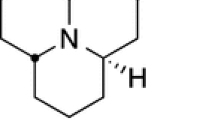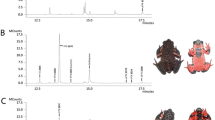Abstract
Poison frogs are chemically defended from predators by diverse alkaloids, almost all of which are sequestered unchanged from alkaloid-containing arthropods in the frog diet. Oribatid mites recently have been proposed as a major dietary source of poison frog alkaloids. Here, we report on alkaloids common to an oribatid mite and poison frogs. Gas chromatographic-mass spectrometric analysis of methanol extracts of adult Scheloribates laevigatus (Oribatida: Scheloribatidae) revealed nine alkaloids. Five of these have been detected previously in the skin glands of poison frogs: two isomers of the pumiliotoxin 291G, two isomers of the 5,6,8-trisubstituted indolizidine 209C, and the 5,6,8-trisubstituted indolizidine 195G. The other four alkaloids, a pumiliotoxin, a tricyclic (coccinelline-like), and two isomers of an izidine, were not previously known, but are similar in structure to alkaloids found in poison frogs. Alkaloids were not detected in immature S. laevigatus, suggesting that they are adult-specific and possibly the result of mite biosynthesis. Although most of the alkaloids detected in S. laevigatus are common to poison frogs, the geographic distributions of these organisms are not sympatric. The findings of this study indicate that oribatid mites, and in particular, members of the genus Scheloribates, represent a relatively unexplored arthropod repository for alkaloids and a significant dietary source of alkaloids in poison frogs.


Similar content being viewed by others
References
Braekman, J. C., Daloze, D., and Pasteels, J. M. 1998. Alkaloids in animals, pp. 349–378, in W. M. Roberts (ed.). Alkaloids: Biochemistry, Ecology, and Medicinal Applications. Plenum Press, New York.
Daly, J. W. 2004. Marine toxins and nonmarine toxins: Convergence or symbiotic organisms? J. Nat. Prod. 67:1211–1215.
Daly, J. W., Spande, T. F., and Garraffo, H. M. 2005. Alkaloids from amphibian skin: A tabulation of over eight-hundred alkaloids. J. Nat. Prod. 68:1556–1575.
Franklin, E., Hayek, T., Fagundes, E. P., and Silva, L. L. 2004. Oribatid mite (Acari: Oribatida) contribution to decomposition dynamic of leaf litter in primary forest, second growth, and polyculture in the central Amazon. Braz. J. Biol. 64:59–72.
Hubert, J., Zilova, M., and Pekar, S. 2001. Feeding preferences and gut contents of three panphytophagous mites (Acari: Oribatida). Eur. J. Soil. Biol. 37:197–208.
Illig, J., Langel, R., Norton, R. A., Scheu, S., and Maraun, M. 2005. Where are the decomposers? Uncovering the soil food web of a tropical montane rain forest in southern Ecuador using stable isotopes (15N). J. Trop. Ecol. 21:589–593.
Ito, F., and Takaku, G. 1994. Obligate myrmecophily in an oribatid mite: Novel symbiont of ants in the oriental tropics. Naturwissenschaften 81:180–182.
Jones, T. H., and Blum, M. S. 1983. Arthropod alkaloids: Distribution, functions, and chemistry, vol. 1, pp. 33–84, in S. W. Pelletier (ed.). Alkaloids: Chemical and Biological Perspectives. Wiley, New York.
Kuwuhara, Y. 2004. Chemical ecology of astigmatid mites, pp. 76–109, in R. T. Cardé and J. G. Millar (eds.). Advances in Insect Chemical Ecology. University Press, Cambridge.
Lindo, Z., and Winchester, N. N. 2006. A comparison of microarthropod assemblages with emphasis on oribatid mites in canopy suspended soils and forest floors associated with ancient western red cedar trees. Pedobiologia 50:31–41.
Macfoy, C., Danosus, D., Sandit, R., Jones, T. H., Garraffo, H. M., Spande, T. F., and Daly, J. W. 2005. Alkaloids of anuran skin: Antimicrobial function? Zeitschrift fuer Naturforschung 60c:932–937.
Maraun, M., and Scheu, S. 2000. The structure of oribatid mite communities (Acari, Oribatida): Patterns, mechanisms and implications for future research. Ecography 23:374–783.
Marshall, V. G., Reeves, R. M., and Norton, R. A. 1987. Catalogue of the Oribatida (Acari) of Continental United States and Canada. Mem. Entomol. Soc. Can. 139:418.
Norton, R. A. 1994. Evolutionary aspects of oribatid mite life-histories and consequences for the origin of the Astigmata, pp. 99–135, in M. Houck (ed.). Mites: Ecological and Evolutionary Analyses of Life-History Patterns. Chapman and Hall, New York.
Piel, J. 2002. A polyketide synthase-peptide synthetase gene cluster from an uncultured bacterial symbiont of Paederus beetles. Proc. Natl. Acad. Sci. USA 99:14002–14007.
Raspotnig, G. 2009. Oil gland secretions in Oribatida (Acari), pp. 235–239, in M. W. Sabelis and J. Bruin (eds.). Trends in Acarology. Proceedings of the XII International Congress of Acarology. Amsterdam.
Raspotnig, G., Schuster, R., and Krisper, G. 2003. Functional anatomy of oil glands in Collohmannia gigantea (Acari, Oribatida). Zoomorphology 122:105–112.
Sanders, F. H., and Norton, R. A. 2004. Anatomy and function of the ptychoid defensive mechanism in the mite Euphthiracarus cooki (Acari: Oribatida). J. Morph. 259:119–154.
Saporito, R. A., Garraffo, H. M., Donnelly, M. A., Edwards, A. L., Longino, J. T., and Daly, J. W. 2004. Formicine ants: An arthropod source for the pumiliotoxin alkaloids of dendrobatid poison frogs. Proc. Natl. Acad. Sci. USA 101:8045–8050.
Saporito, R. A., Donnelly, M. A., Norton, R. A., Garraffo, H. M., Spande, T. F., and Daly, J. W. 2007a. Oribatid mites as a major dietary source for alkaloids in poison frogs. Proc. Natl. Acad. Sci. USA. 104:8885–8890.
Saporito, R. A., Donnelly, M. A., Jain, P., Garraffo, H. M., Spande, T. F., and Daly, J. W. 2007b. Spatial and temporal patterns of alkaloid variation in the poison frog Oophaga pumilio in Costa Rica and Panama over 30 years. Toxicon 50:757–778.
Saporito, R. A., Donnelly, M. A., Norton, R. A., Garraffo, H. M., Spande, T. F., and Daly, J. W. 2008. Erratum: Oribatid mites as a major dietary source for alkaloids in poison frogs. Proc. Natl. Acad. Sci. USA. 105:17586.
Saporito, R. A., Spande, T. F., Garraffo, H. M., and Donnelly, M. A. 2009. Arthropod alkaloids in poison frogs: A review of the ‘dietary hypothesis’. Heterocycles 79:277–297.
Schneider, K., and Maraun, M. 2005. Feeding preferences among dark pigmented fungal taxa (“Dematiacea”) indicate limited trophic niche differentiation of oribatid mites (Oribatida, Acari). Pedobiologia 49:61–67.
Schneider, K., and Maraun, M. 2009. Top-down control of soil microarthropods—evidence from a laboratory experiment. Soil. Biol. and Biochem. 341:170–175.
Shimano, S., Sakata, T., Mizutani, Y., Kuwahara, Y., and Aoki, J. I. 2002. Geranial: The alarm pheromone in the nymphal stage of the oribatid mite, Nothrus palustris. J. Chem. Ecol. 28:1831–1837.
Simon, M. P., and Toft, C. A. 1991. Diet specialization in small vertebrates: Mite-eating in frogs. Oikos 61:263–278.
Takada, W., Sakata, T., Shimano, S., Enami, Y., Mori, N., Nishida, R., and Kuwahara, Y. 2005. Scheloribatid mites as the source of pumiliotoxins in dendrobatid frogs. J. Chem. Ecol. 31:2403–2415.
Valderrama-Vernaza, M., Ramírez-Pinilla, M. P., and Serrano-Cardoza, V. H. 2009. Diet of the Andean frog Ranitomeya virolinensis (Athesphatanura: Dendrobatidae). J. Herp. 43:114–123
Weigmann, G. 2006. Hornmilben (Oribatida). Die Tierwelt Deutschlands, 76. Teil. Goecke & Evers, Keltern.
Weldon, P. J., Kramer, M., Gordon, S., Spande, T. F., and Daly, J. W. 2006. A common pumiliotoxin from poison frogs exhibits enantioselective toxicity against mosquitoes. Proc. Natl. Acad. Sci. USA. 103:17818–17821.
Wilson, E. O. 2005. Oribatid mite predation by small ants of the genus Pheidole. Insectes Soc. 52:263–265.
Woodring, J. P., and Cook, E. F. 1962. The biology of Ceratozetes cisalpinus Berlese, Scheloribates laevigatus Koch, and Oppia neerlandica Oudemans (Oribatei), with a description of all stages. Acarologia 4:101–137.
Acknowledgments
J.M. Snyder provided comments that improved the quality of this manuscript. An NIH Courtesy Appointment and a National Science Foundation Postdoctoral Research Fellowship supported R.A.S. The research at NIH was funded by intramural funds of NIDDK.
Author information
Authors and Affiliations
Corresponding author
Electronic supplementary material
Rights and permissions
About this article
Cite this article
Saporito, R.A., Norton, R.A., Andriamaharavo, N.R. et al. Alkaloids in the Mite Scheloribates laevigatus: Further Alkaloids Common to Oribatid Mites and Poison Frogs. J Chem Ecol 37, 213–218 (2011). https://doi.org/10.1007/s10886-011-9914-7
Received:
Revised:
Accepted:
Published:
Issue Date:
DOI: https://doi.org/10.1007/s10886-011-9914-7




